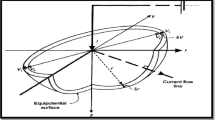Summary
A theoretical solution is obtained for the problem of a three and four layered earth model with transitional boundary. In practice, the transition layer can stand for fresh water bearing sand and fine gravels. The master curves for Schlumberger electrode configuration and table of data are presented for the case when the lower half space is infinitely resistive.
Similar content being viewed by others
References
N. W. McLachlan,Bessel functions for engineers (Oxford University Press, 1955).
H. Flathe,Possibilities and limitations in applying geoelectrical methods to hydrogeological problems in the coastal areas of north-west Germany, Geophysical Prospecting3 (1955), 95.
H. M. Mooney, E. Orellana, H. Pickett andL. Tornheim:A Resistivity Computation method for layered earth models, Geophysics31 (1966), 192.
K. Mallick andA. Roy,Resistivity sounding on a two layer earth with transitional boundary, Geophysical Prospecting16 (1966), 436.
P. K. Bhattacharya andH. P. Patra,Direct current geoelectric sounding (Elsevier Publishing Company, 1968).
Author information
Authors and Affiliations
Rights and permissions
About this article
Cite this article
Rathor, B.P.S., Rathor, H.S. A resistivity computation method for layered earth models with transition boundary. PAGEOPH 85, 153–160 (1971). https://doi.org/10.1007/BF00875405
Received:
Issue Date:
DOI: https://doi.org/10.1007/BF00875405




